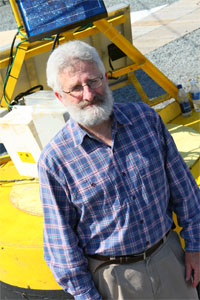 |
| A boat brings a group of high school students to see┬аweather buoys┬аin Lunenburg Bay.┬а(Pearce photo) |
Field trips are fun wherever your teacher decides to take you, but Stevenson Lawrence figures his class has hit the jackpot with its leisurely cruise of Lunenburg Bay. As the boat putt-putts back into dock behind the Fisheries Museum of the Atlantic, the teenager is just getting revved up.
тАЬI think itтАЩs amazing тАУ look what technology is telling us,тАЭ says the student from New Germany Rural High School, who throws in a few тАЬawesomesтАЭ and тАЬphenomenalsтАЭ when approached by a Global TV reporter.┬а
тАЬI do, I think itтАЩs cool. You can be anywhere in the world and you can find out the water temperature, the air pressure, the wind speed, whatever, for a spot right by here. And all from buoys powered by the sun.тАЭ┬а
On Friday, scientists with the Centre for Marine Environmental Prediction (CMEP) held an open house at the Lunenburg museum to explain what theyтАЩve been up to for the past five years. There were boat tours to see the meteorological instrumentation out at sea and booths explaining the scientific concepts under a tent dockside.
About 500 school children attended, as well as many local residents curious about the strange-looking yellow buoys bopping around Lunenburg Bay. There are three of them out there, collecting data on air temperature, wind speed, wind direction, humidity, salinity, bottom pressure and bottom temperature. Outfitted┬аwith solar panels, the buoys collect information which is transmitted by radio antennas to ║┌┴╧│╘╣╧═Ї and posted directly to CMEPтАЩs web site.
 |
| John Cullen is the Killam Chair in Ocean Studies at ║┌┴╧│╘╣╧═Ї and co-investigator of the Centre for Marine Environmental Protection.┬а(Pearce photo) |
Out on the boat, oceanographer Richard Davis bellows over the motor to students who have their faces framed by rigid orange life jackets: тАЬAll the really cool stuff is beneath the water,тАЭ he says as the boat approaches the first buoy. There are monitors onboard to show whatтАЩs going on beneath the waves, and he points out a lumpfish that has been keeping company with the acoustic pod on the ocean bottom all day.
Mr. Davis, a former project manager for CMEP, explains the project is in limbo, nearing the end of its five-year mandate with no indication from the federal government if it will be renewed or not. But in five years, theyтАЩve learned a lot, he says, and have been able to develop a forecasting ability for ocean weather by studying the links between weather and ocean processes. This kind of information can be used to predict if a storm surge is coming, for example, if the waterтАЩs too cold for lobster fishermen to put out their traps, or if itтАЩs too choppy or foggy out at sea for whale watching.
But while scientists are able to provide 24-hour and 48-hour forecasts of ocean weather with some accuracy, theyтАЩve only scratched the surface when it comes to understanding how the ocean is responding to long-term climate change. That science is in its infancy, says John Cullen, co-principal investigator for CMEP and the Killam Chair in Ocean Studies at ║┌┴╧│╘╣╧═Ї.┬а
тАЬWe wish we could go further,тАЭ he says. тАЬBut the project ends in MarchтАж Before that happened, we wanted to be able to share what weтАЩve been able to do with the people of Lunenburg, whoтАЩve been so supportive.тАЭ
